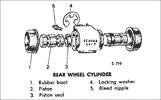How-To:
How To Rebuild Your Sonett Brake System
Please note: The following mechanical advice is offered to enhance the overall knowledge of the automobiles owner only. Any and all work described in the following article should be performed by a licensed mechanic only. The author shall be held harmless in the event of injury or accident by the automobiles owner and occupants, should the work be performed by an unlicensed mechanic.
Introduction
After twenty plus years your Sonett is probably ready for a complete brake system rebuild. Some of the more common symptoms of a tired brake system include:
- leaking rear wheel cylinders or calipers
- brakes that will not release fully
- car pulls to one side
- brake pedal pulsation
If you don�t want to chase these kinds of problems from one end of your car and back again, you should go with a complete system rebuild. A rebuild of the brake master cylinder is covered here. Use that article in conjunction with this one for a complete rebuild of the brake system.
Parts List and Availability
For Brake System part numbers and manufacturers, go here
Instructions
Keep in mind that the following instructions cover a complete brake system overhaul. Many of the steps can be skipped entirely if only a partial job is being performed. You will note that I have left out most reassembly instructions from this article. Where no reassembly instructions are given, simply reverse the disassembly instructions.
If replacing the rotors (brake disc), remove the axle split pin (cotter pin) and castle nut before jacking up the car. Jack up the car, remove the wheels. Flatten the ends of the long split pins that secure the spring retaining clips and remove.
DISC BRAKE COMPONENTS FROM MODEL 1967

Front Brake Disassembly
Pull out the retaining clips; if they are rusty they should be replaced. Pull out the brake pads; note that the friction material is beveled. The new pads must be installed with the bevels facing the same way. The inner pad may or may not have a metal shim clipped over it. Saab added the shims at some point to prevent squeaking. If you�re just replacing the pads, you must compress the caliper piston with a flat bar to make room for the new thicker pads. Be careful to keep the piston square in the bore during compression. Keep an eye on the brake fluid reservoir to make sure that it doesn�t overflow during compression.
Helpful hint:
If compressing the piston is a problem, open the bleeder to allow the fluid to escape during piston compression.
Caliper Piston Removal
After removing the pads, pump the brake pedal to force the pistons out of the bore. Have a pan ready under the calipers to catch the brake fluid. If the pistons will not come out completely (they usually don�t), they can be twisted out by hand or blown out later with compressed air. Open the rear bleeders, pump the brake pedal until fluid stops running out. Unscrew the rubber brake hose from the back of the cylinder body just enough to loosen it (1/4 turn). Bend back the locking tab washers on the two bolts that secure the caliper assembly to the driveshaft carrier, remove the bolts. Spin the entire caliper assembly to remove it from the brake hose.
Brake Hose Removal
Working from inside the engine compartment, remove the nut that secures the steel brake line to the back of the brake hose. Now remove the nut and lock washer that holds the brake hose to the inner fender well. Warning-The area above the brake master cylinder is notorious for rust. This, combined with a very confined work area, almost always makes for a less than satisfying experience.
Steel Brake Line Replacement
If the outside of the brake lines have deep pitting or scale, they should be replaced. Even if the lines appear to be all right on the outside, they are often lined with scale or sludge. No amount of bleeding will remove this and it can cause leaking calipers and wheel cylinders over time. To replace the steel brake lines you will need a flaring tool capable of �double flares� and a tubing cutter. Bring your old lines to an auto parts store and buy new tubing of the same diameter and longer in length. Cut the tubes to the correct length after bending them to fit the car. Be careful that the threaded connectors on the new lines have the same thread as the old ones. If you can�t find the correct threaded connectors (I never seem to), don�t worry, just remove the old connectors and reuse them on the new tubing (condition permitting of course). If you have never used a flaring tool before, be sure to have someone with experience give you a few lessons before trying it yourself. The tubing can be bent very easily to match the originals. To prevent kinking the lines, bend them over a hard cylindrical object like a coffee can. Always deburr the inside diameter of the lines after cutting to prevent flow restrictions. Never bend the lines after they are installed, as this will put permanent stress on the connectors.
Rotor Replacement
With the caliper assembly already removed, use a wheel puller to remove the hub (with the rotor still attached) from the splined end of the axle. The rotor can now be unbolted from the hub and replaced.
Caliper Rebuilding
Make a note as to how the two springs that secure the cylinder body to the caliper assembly are fastened before removal. With the springs removed, the cylinder body can be slid out of the caliper assembly. Sometimes a good smack with a rubber hammer is needed. The caliper assembly pivots on a hinge pin, the assembly can be opened up, pivoting on the pin to gain better access to the cylinder body. Clean and lightly oil the area around the pin before reassembly. If the piston is still stuck in the cylinder body, compressed air can now be used to blow it out. Be careful, the piston will shoot out like a champagne cork! If the caliper piston�s chrome plating is pitted or cracked, it should be replaced. Pry out the wiper seal along with its metal retainer. Remove the piston seal noting its beveled edge. Clean out the cylinder body with brake fluid paying special attention to the wiper seal-retaining groove. Install the new piston seal. With the groove facing inward, press the wiper seal inside the retainer. Tap the retainer inside the cylinder body being extra careful not to bend it. Do not hit the retainer directly with a hammer. Place a wood block on top of the retainer to prevent it from being damaged. Saab made a special installation tool for the retainer and you will probably wish you had one. Lubricate the seals with special brake lube or brake fluid. Press in the piston leaving about 1/4� sticking out.
Rear Brake Drum Removal
Tap off the axle end cover using a screwdriver and hammer. Remove the cotter pin, castle nut and washer. Make sure the emergency brake is released, and then back off on the brake adjuster located on the rear of the drum. Using a drum puller, remove the drum.
Brake Shoe Removal

Remove the two spring retainers by grasping them with a pair of pliers, pushing in, and turning 90� to release. Before removing the shoes, note the attachment of the return springs and the position of the friction material on the shoes. You will notice that the friction material is offset to one end of the shoe. The new shoes must be installed the same way. Remove the shoes by forcing the top of them apart, against the pressure of the return springs. This will allow the shoes to be removed from the adjuster mechanism. Pry the bottom of the shoes out of the wheel cylinder while simultaneously removing them from the hand brake link. With the shoes removed, the adjuster should be completely unscrewed, taken apart, cleaned and oiled.
Wheel Cylinder Removal and Rebuilding

Remove the nut that attaches the steel brake line to the rear the cylinder. Press off the locking clip that holds the cylinder to the backing plate. Tap out the cylinder. Remove the dust covers and pull out the pistons. Using a small two stone hone with plenty of brake fluid as a lubricant, hone the bore just enough to smooth it out. If the bore is pitted, the cylinder must be replaced. Clean all parts with brake fluid. Install new piston seals with the bevel facing correctly. Lubricate seals with special brake lube or brake fluid. Press in pistons and install new dust covers.
Brake Fluid
I really don�t want to start a debate on the use of silicone (dot 5) brake fluid, but I�ll put in my two cents worth anyway. Here are a few facts that you should know about Silicone brake fluid. Silicone does not absorb water like dot 3 or 4. This can help prevent leaky brake cylinders in cars that are stored for the winter. Silicone fluid can make your brake pedal feel squishy. Silicone fluid will leak past worn rubber seals more readily than dot 3 or 4. I would not recommend using dot 5 unless all rubber seals have been replaced (including the ones in the brake master cylinder). All of the old fluid must be bled out before using Dot 5, never mix fluid types.
Brake Bleeding
The Two-Person Method
Close all of the bleeders except the passenger side (right) rear. Place a clear plastic tube over the bleeder, put the other end in a clear bottle or glass. Fill the brake fluid reservoir. Two people are required, one to slowly pump the pedal and the other to open and close the bleeder with each pump of the pedal. The tube must be kept in the bottom of the glass, immersed in fluid. When the pedal is depressed the bleeder is open, when the pedal is raised, the bleeder is closed, the �pedal person� must call out �up� or �down� so that the other person knows when to open and close the bleeder. The idea is to get all of the air out of the system. When you stop getting air bubbles move to the left front, followed by the left rear and right front. Don�t forget to refill the reservoir as needed. You probably will have to make the rounds two or more times before all of the air is removed. Remember, patience is a virtue!
The One-Person Method
Buy a six foot long piece of clear fish tank tubing. Make sure the tube fits over the bleeder nipples tightly. Tape one end of the tube to the top of a broom handle or shovel. Lean the shovel/broom up against the car near a wheel. Slip the other end of the tube over a bleeder nipple and open it up a turn. The idea is simple. While sitting in your car you can slowly pump the pedal while watching the brake fluid rise inside the clear tube. The air bubbles simply escape out of the top of the tube. When you stop seeing bubbles, close the bleeder and move on to the next one. Use the same bleeding sequence as mentioned in the �two person method�.
Brake Adjustment
The front brakes are self-adjusting, as the pads wear down the caliper piston moves out, maintaining correct pad pressure. To adjust the rear brakes, jack the wheel up off the ground. Spin the wheel while tightening the adjuster until the wheel stops spinning. Back off the adjuster just enough to allow the wheel to spin. Pump the brake pedal a few times and readjust. New rear shoes will �bed in� quickly, throwing the brakes out of adjustment. Check them again after a thousand miles or so.
Drive it! So there you have it, not a small job by any means, but then what is, on a vintage Saab! Just one last suggestion, before you rush out and start ordering parts, do a little comparative shopping, you might save a bundle.
Bruce Turk, 7/01


